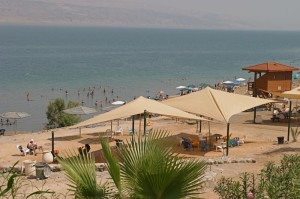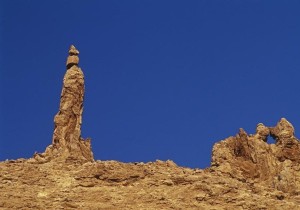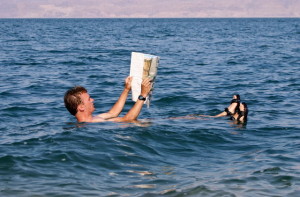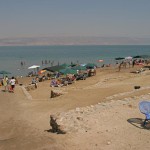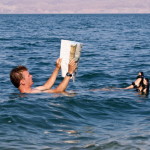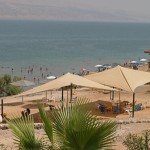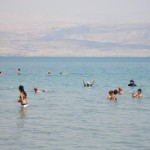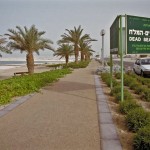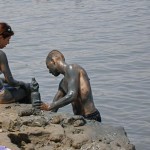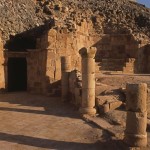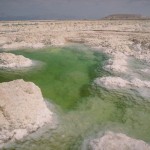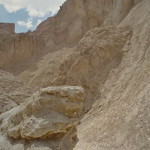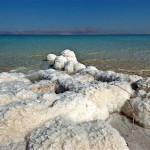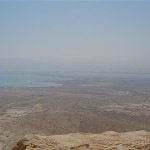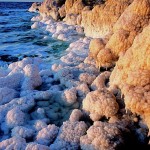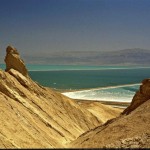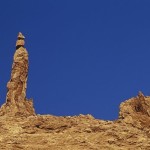Israel/Jordan/West Bank
The Dead Sea, which shimmers like a blue mirror under all-day sunshine, is one of the most unusual bodies of water in the world.
It is set in the lowest dry land on earth, so it has no outlet. It is so loaded with minerals that no fish can live in it. It is so dense that bathers can lie back on its surface and read a newspaper.
The Dead Sea is located about 25km east of Jerusalem, along the border between Israel and Jordan. About half of it is actually in Jordanian territory.
The ancient Hebrews called this body of water the Sea of Salt. Other ancient names include the Sea of Solitude, the Sea of Arabah and the Asphalt Sea. The Crusaders called it the Sea of Satan.
The Dead Sea’s therapeutic qualities attracted Herod the Great. Its minerals and sticky black mud provided balms for Egyptian mummies and cosmetics for Cleopatra.
Now its health resorts treat psoriasis and arthritis, its skin-care products are marketed worldwide, and its industrial evaporation pans harvest potash and other minerals.
Wicked cities were destroyed
The region has many biblical connections. Here, though their locations are unknown, the wicked cities of Sodom and Gomorrah were destroyed by God with “sulphur and fire” and Lot’s wife was turned into a pillar of salt for looking back at the destruction (Genesis 19:24-26). Among the salt encrustations around the sea is an unusual column at the southern end called Lot’s Wife (though it is 20 metres high).
On the eastern side, the highest peak visible is Mount Nebo, where Moses glimpsed the Promised Land. Further south stands the fortress of Machaerus, where Herod Antipas imprisoned and then executed John the Baptist.
On the western side, from north to south, are Qumran, where the Dead Sea Scrolls were found; Ein Gedi, where David hid from King Saul in a cave (and cut off a corner of the king’s cloak when he entered the cave to relieve himself); and Herod the Great’s fortress of Masada.
Evaporation concentrates the minerals
By 2013 the Dead Sea was 50km long, 15km across at its widest point, and 430 metres below sea level. Its area was constantly shrinking and the water level was dropping by more than a metre a year.
Because it has no exit, water is lost only through evaporation, which leaves behind the minerals. The Dead Sea is nearly 10 times as salty as the open seas. The high concentration of minerals (predominantly magnesium chloride) provides the buoyancy that keeps bathers suspended — as well as a bitter taste.
A low promontory of land called el-Lisan (“the tongue”) projects across the sea from the east, dividing the southern third from the northern section. The southern part is now devoted to evaporation pools for mineral extraction.
Most of the water that once flowed from the Jordan River into the Dead Sea is being diverted for drinking water and agricultural purposes, so there is not enough to offset the high evaporation rate.
Since the late 1980s the landscape around the sea has been reshaped by thousands of sinkholes — caused by fresh water from the mountains dissolving underground levels of salt. This phenomenon has caused some tourist beaches in Israel to close.
Rescue proposals to prevent the sea drying up have included canals to bring water from the Mediterranean Sea or the Red Sea.
If the Dead Sea becomes rejuvenated with fresh water, this could fulfil a prophecy in Ezekiel 47:8-10, that it will “become fresh . . . and there will be very many fish”.
In December 2013, representatives of Israel, Jordan and the Palestinian Authority agreed on a long-term desalination project in which brine would be piped about 180 kilometres from Aqaba, Jordan, to replenish the Dead Sea.
Related sites:
In Scripture:
God destroys Sodom and Gomorrah: Genesis 19:24-26
Prophesy that the Dead Sea will become fresh: Ezekiel 47:8-10
- Seashore scene at the Dead Sea (© Tom Callinan / Seetheholyland.net)
- Afloat in the Dead Sea (David Niblack)
- Bathers by the shore of the Dead Sea (© Tom Callinan / Seetheholyland.net)
- Different poses in the Dead Sea (Seetheholyland.net)
- Dead Sea promenade (© Israel Ministry of Tourism)
- Sticky black mud from the Dead Sea is believed to have therapeutic qualities (Seetheholyland.net)
- Lot’s Cave, on Jordanian side of Dead Sea (© Visitjordan.com)
- Salt deposits in the south of the Dead Sea (© Israel Ministry of Tourism)
- Mount Sodom at the southern end of the Dead Sea (© Israel Ministry of Tourism)
- Salt deposits on shore of the Dead Sea (© Israel Ministry of Tourism)
- Dead Sea from Masada (Seetheholyland.net)
- Salt formations on the shore of the Dead Sea (© Israel Ministry of Tourism)
- Dead Sea salt ponds seen from Mount Sodom (© Israel Ministry of Tourism)
- Pillar of salt, on Jordanian side of Dead Sea, known as Lot’s Wife (© Visitjordan.com)
References
Anonymous: “The Dead Sea”, Holy Land, summer 2005
Charlesworth, James H.: The Millennium Guide for Pilgrims to the Holy Land (BIBAL Press, 2000)
Dyer, Charles H., and Hatteberg, Gregory A.: The New Christian Traveler’s Guide to the Holy Land (Moody, 2006)
Freeman-Grenville, G. S. P.: The Holy Land: A Pilgrim’s Guide to Israel, Jordan and the Sinai (Continuum Publishing, 1996)
Frumkin, Amos: “How Lot’s Wife Became a Pillar of Salt”, Biblical Archaeology Review, May/June 2009
Kershner, Isabel: “A Rare Middle East Agreement, on Water”, New York Times, December 9, 2013
Lidman, Melanie: “As the Dead Sea dries, its collapsing shores force a return to nature”, Times of Israel, February 13, 2017
Martin, James: A Pilgrim’s Guide to the Holy Land (Westminster Press, 1978)
Murphy-O’Connor, Jerome: The Holy Land: An Oxford Archaeological Guide from Earliest Times to 1700 (Oxford University Press, 2005)
Walker, Peter: In the Steps of Jesus (Zondervan, 2006)
External links

